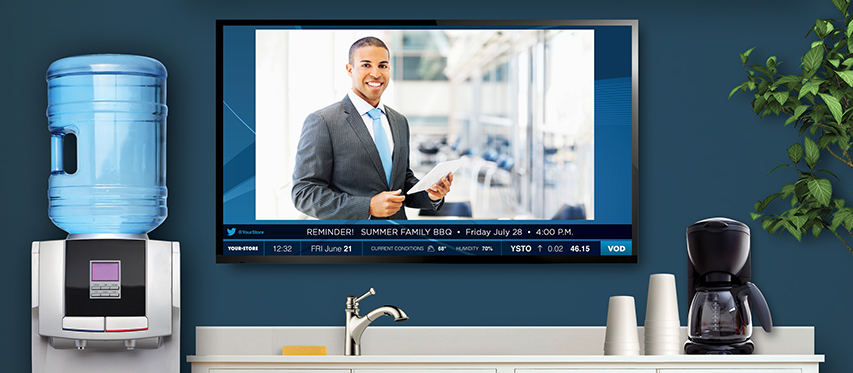Tame the Cost of Employee Turnover With Breakroom TV

Imagine you are starting as a new manager at a local retail location. Your regional vice president pulls you aside and tells you that your store will start the year $200,000 in the red. You are shocked and ask why? Because we have 60 percent turnover at the store and each employee who leaves costs the company $3200.
Employee turnover is a critical issue in many sectors, not just retail. Hotels top the list with more than 70 percent turnover, and financial services have a low turnover of 16 percent, but a single employee leaving will cost about $19,000. It’s difficult news no matter where you are working. Both the restaurant and c-store industries also have over 50 percent turnover rates. If your paycheck depends on location profitability, then you are motivated to help create a culture that binds employees to the business and encourages long term employment.
The foundation of this culture is communication, recognition and growth. Every employee wants to hear how their role in the company is contributing to the overall success of the organization.
The first piece of our business case is the “What.”
Breakroom TV is an LG Commercial SmartTV with the Hughes MediaSignage Application installed and connected to the Hughes SaaS content management service in the cloud. It is a simple, easy and reliable digital signage solution. There are options that can be added, such as installation, maintenance and training services, but the core of the service is a SmartTV and SaaS content management. The base package will cost about $3440 for three-year total cost of ownership, and the digital signage benefits far outweigh the cost.
That covers the “What?” of the Breakroom TV business case. Now let’s turn to the “Why?”
| Industry | Turnover Rate | Cost of Employee Leaving |
|---|---|---|
| Retail | 60 to 67% | $3,200 per employee |
| Restaurant | 67 to 73% | $5,800 per employee |
| Financial Services | 16 to 18% | $19,000 per employee |
| Hotel | 70 to 74% | $5,800 per employee |
| C-Store | 54% | $3,900 per employee |
Let me share a simple story with you. Diane is the CEO of large, well-respected retail chain. She has more than 1000 stores and over 120,000 employees. Diane is well liked by her team and the broader company. One morning Diane is awakened by a call from the CIO. Their credit card data had been hacked overnight and the story is going to be on the morning news programs. Immediately Diane begins to think about her customers and her employees. How can she help them understand what has happened and hold their trust and loyalty?
Diane knows that in a crisis, communication must be firm, direct and open. She gets to the office early and goes into the video room and records a seven minute segment in which she explains what happened, what the apparent damage is and what has been done to mitigate the problem and prevent future occurrences. She then talks about why it is OK for customers to make purchases and trust that their data is safe. She provides a three-point message with confidence, humility and sincerity. Her team then puts this video into their Breakroom TV system and before the stores open each employee is asked to gather in the break room and watch the video.
The result? By taking advantage of the latest technologies with breakroom and waiting area TVs, Diane knows that employees around the company can greet customers with a confident smile and when the customer comments on the news about a breach, the employee is able to provide a concise, direct and clear message of security and safety, just like they heard directly from their CEO that morning. No ambiguity, no wondering, no local variations, just firm, direct and open communication.
Because of her quick action and because of her ability to get the word out quickly, the company can avoid many of the problems that arise when local media get a local version of the story from the store – and it doesn’t align with the national message from HQ.
The final piece of our business case is the how, as in "How can I afford to roll this out?"
If your location has 60 employees and you have 60 percent turnover, that means that you will lose 36 employees during the coming 12 months. Each of those departures costs you $3200. You’re facing a negative impact of more than $115,000 just from turnover. You’re not going to fix retail turnover, but if you communicate, recognize and develop your team, you have a much better chance of keeping them working on your team. What if you were able to save two of those employees from leaving? Using Breakroom TV to communicate, recognize and train or develop your teams will create that culture that keeps employees here. If you stop one employee from leaving each year, you’re saving $3200 per employee and paying for the system in year one.
The business case for Breakroom TV is this. Your employees are your most valuable resource and they require time, attention and care. If you could reduce churn by one person per store, you would return back to the company more than two million dollars per year. Think of what could your company do with $2M in available cash each year.
Contact us or watch our recent webinar to learn more about Breakroom TV, waiting area TV, and other digital signage in retail opportunities and we’ll show you how it can improve your bottom line.